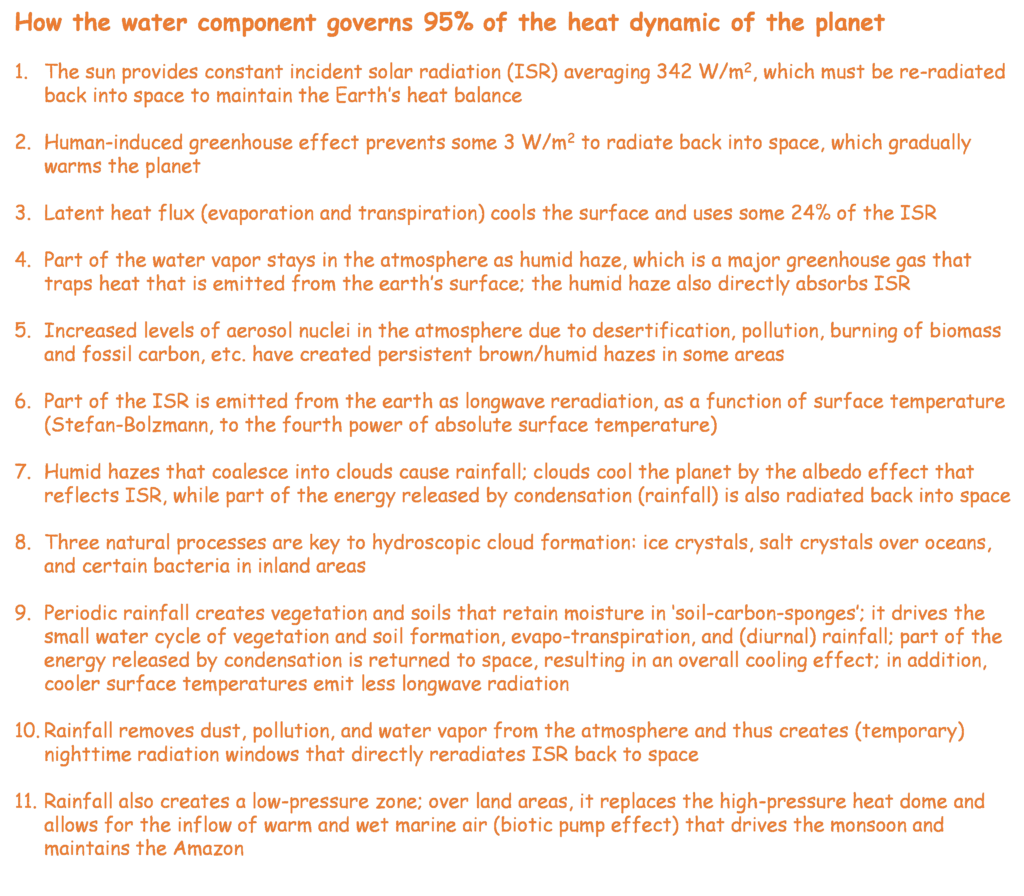In a webinar from 2019 “Restoring the water cycle to cool the climate”, Walter Jehne argues that rehydrating the landscape is an effective nature-based solution to mitigate—and in the long run reverse—global warming (I have added a link to the webinar at the bottom of this post).
Jehne asserts that a rise in atmospheric CO2 levels is locked in—irrespective of government policies—because of the lag effect of surplus CO2 absorbed by the oceans. CO2 management, however necessary, is therefore not going to stop global warming. Let alone reverse it.
In Jehne’s view, the way out is landscape rehydration by restoring the water cycle. Apart from cooling the climate, landscape rehydration carries many additional benefits regarding biodiversity, wildfire mitigation, arresting and reversing aridification, and flood protection, to mention just a few.

How does it work?
In his webinar, Jehne explains that 95% of the heat dynamics of the planet is governed by water. In comparison, the CO2 component represents less than 4% of the global heat dynamics. This explains why a CO2 response alone is probably not going to do the trick (to arrest and reverse global warming in the mid-term future). By contrast, focusing on the water cycle will be much more effective. And easier.
Here are some basic numbers. The average incidence solar radiation (ISR) at the top of the troposphere is 342 W/m2. It must be reradiated back into space to maintain the Earth’s heat balance. The human-induced greenhouse effect traps some 3 W/m2 that is gradually heating the planet. We must figure out a way to send this surplus back into space to maintain the (exceptionally stable) climate that has prevailed during most of human civilization.
The proposed interventions are based on the below enumeration, which describes in a simplified manner how the hydraulic cycle affects the heat dynamic of the planet.

Interventions
Rehydrated landscapes impact on many elements in the above schematic.
First, land management practices that capture rainfall and slow-down runoff will regenerate the vegetation cover and soil-carbon-sponge that drives the ‘small water cycle’, if implemented at scale. This cycle is conceptualized as a closed circulation in which water evaporates from a land area and then returns to the same terrestrial environment as rain. It has massive dividends in terms of moisture and nutrient availability. Because part of the heat associated with condensation (rainfall) is emitted back to space, the small water cycle also cools the planet. In addition, rainfall removes the humid/brown hazes, and thus temporarily creates radiation windows that directly re-radiates ISR back to space (no. 10 in the above schematic).
Further, forests, wetlands, and grasslands generate precipitation nuclei (microbes) that are necessary for cloud formation.

A rehydrated landscape is also much cooler than a dry or dehydrated landscape because the latent heat of vaporization cools the surface. Hence it emits much less heat into the atmosphere (see No 6 in the above schematic; Stefan Bolzmann, to the fourth power of absolute T), which is subsequently trapped by the humid/brown hazes.
By comparison, ISR that is used for latent heat flux (evaporation and transpiration) and transported to the top of the atmosphere is partly radiated back to space during a rain event.
Hence all land management practices that keep lands vegetated (and soils covered) directly cool the planet. In addition, vegetated lands generate less dust while hydrated lands are less susceptible to wildfires that bring massive quantities of pollutants into the atmosphere. These aerosols are at the core of the brown hazes that later serve as heat traps (the ‘green house’).

Where do we have agency?
Land management represents an effective and practical point of agency to restore the earth’s climate since it can be implemented by farmers, local communities, and land management agencies and does not depend on the central government or collective action at scale by millions (or billions) of individuals.
Besides, there are many direct benefits for landowners, which include:
- increased soil moisture storage
- increased resilience against climate variability and droughts
- healthy soil formation and more soil nutrients
- erosion protection
- micro-climates that provide favorable conditions for selected agricultural activities
- capital appreciation of land
- increased farm income
At a slightly larger scale, the benefits include:
- increased groundwater replenishment
- restored landscape functions
- carbon sequestration in soils and vegetation
- more food and enhanced food security
- rural development and rural poverty alleviation
- flood mitigation and higher low flows in downstream waterways
- increased biodiversity
- more resilience against forest fires
Now let’s be a little more practical. Land management practices that restore the hydraulic cycle include:
- Plant stimulating grazing systems (Allan Savory’s holistic grazing management)
- Regenerative agriculture including no-till cultivation
- Agro forestry
- Reforestation and expansion of protected areas—which is becoming easier in parts of Europe and North America and elsewhere because of depopulation of rural areas
- Improved forest fire management practices, maybe with animals? (‘if you can’t beat it, eat it)
- No stubble burning (rather, promote decomposition by adding enzymes or other methods)
- Permaculture for smallholders
- Green infrastructure in urban areas
- Etc.
Closing comments: the ever-expanding benefits of responsible land management.
Water and land management are closely linked. Further, as many of us are well aware, they are both related to agricultural practices, food security, and environmental integrity. Walter Jehne expands this nexus with climate management. It transpires that responsible land management carries ever expanding benefits. Moreover – it is doable at scale and may offer a practical way out of the climate crisis. Hectare by hectare, farm by farm, land holding by land holding!
The content of the above post has been beautifully explained and summarized by Jimi Sol
The Guardian published an article that illustrates the above discussion. It’s all there: cooler landscapes, more rainfall, stronger monsoons, etc.
